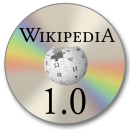Wikipedia:Version 1.0 Editorial Team/Release Version Criteria
| This page is currently inactive and is retained for historical reference. Either the page is no longer relevant or consensus on its purpose has become unclear. To revive discussion, seek broader input via a forum such as the village pump. |
| This page in a nutshell: We are periodically releasing select groups of Wikipedia articles for offline use. This page summarizes the inclusion criteria for each release. |
Release Version 0.5
[edit]A selection of around 2000 articles was made manually, containing all countries, global cities, planets, chemical elements, as well as a large selection of non-obscure featured articles.
Release Version 0.7
[edit]Nominations closed, completed. See Wikipedia:Version 0.7. For this release we selected around 30,000 articles, so the scope was much wider than for Version 0.5. A bot was used to make the main selection, with a few additional articles nominated and selected manually. These typically encompassed:
- Articles that give context (Poverty for Poverty in Pakistan)
- GA+ articles of mid importance or higher
- B-Class articles of high importance or higher
- C-Class articles of high importance or higher
- Start-Class articles, if they are part of a set or are essential. Additional Start-Class articles may be selected by the bot if they are found to score very highly on importance parameters.
- Articles needed for completeness
- Country subdivisions of major countries (for example, Australian states)
For more details on importance see below, and Wikipedia:Release Version/Scope (NB: this Scope page needs updating, as of September 2008.)
Release Version 0.8
[edit]Nominations closed, completed. See Wikipedia:Version 0.8. For this release we selected around 47,000 articles, so the scope was much wider than for Version 0.7. A bot was used to make the main selection, with a few additional articles nominated and selected manually. These typically encompassed:
Release Version 1.0
[edit]As of July 2019[update] release 1.0 is on hold, although the WP:Content assessment procedures are still in use.
Priority of topic
[edit]
This is judged using both manual assessment by a WikiProject member, and "external interest" judged by links-in, interwiki links and number of pageviews. For more details, and the formula used to balance these parameters, see Wikipedia:Version 1.0 Editorial Team/SelectionBot.
By "priority" or "importance" of topics for the overall offline release, we generally mean to indicate the level of expectation or desire that the topic would be covered in a traditional encyclopedia.
WikiProject priority assessments
[edit]| Need | The article is of priority or importance, regardless of its quality |
| Top | Subject is a must-have for a print encyclopedia |
| Mid | Subject fills in more minor details |
| Low | Subject is mainly of specialist interest. |
| Bottom | (Optional) Subject has no real significance to the project. |
| No | (Optional) Subject is a disambiguation or redirect page, residing in article space. |
See the table on the right for a summary of manual assessment levels. For an example of this table adapted to a specific subject area, see Wikipedia:WikiProject Psychology/Assessment#Importance scale or Wikipedia:WikiProject Comics/Article Classification/ImportanceCategoryHeader. Other projects are strongly encouraged to emulate this customized approach, including the use of exemplars.
Within a WikiProject, importance or priority must be regarded as a relative term. If importance values are applied within a specific project, these only reflect the perceived importance to that project. An article judged to be "Top-Importance" in one WikiProject's context may be only "Low-Importance" for another WikiProject.
Consider a hierarchy such as History -> History of Europe -> History of Poland -> Polish kings and queens. An article labeled as "Top-Importance" for the subject of history would almost certainly warrant inclusion in all general releases. A "Top-Importance" article for the history of Poland would be a reasonable candidate for inclusion, but some "Top-Importance" articles on Polish kings & queens may not be included in early releases.
Ranking within a subject area is very helpful in deciding which articles are included first as the scope of the Wikipedia 1.0 project expands. Quality articles which are not considered to be on topics important enough for inclusion on the current release will be held in a held nominations page, ready for inclusion as the scope expands.
Proposed quality standards
[edit]Articles can be assessed using the WP:1.0 assessment scheme.[clarification needed] At least for now, articles are not expected to reach Featured Article standard. They are expected to be reasonably satisfactory for an ordinary reader. The following are minimum guidelines. Reviewers should use their judgment to determine whether more is required of any given entry.
For manual reviews, at least two people should give the article a moderate level of review and agree that it meets the standard. This would normally be the nominator and a member of the Review Team.
Our goals are listed below:
- Any easily fixable problems should be fixed.
- In no particular order, articles should:
- have a neutral point of view,
- be reasonably clear,
- be organized adequately,
- have no known factual errors,
- have appropriate categorization,
- be adequate in scope and proportion,
- use style consistently within the article,
- be visually adequate (that is, not ugly),
- use correct grammar, spelling and punctuation,
- list at least one appropriate reference, source, further information item, or external link. A link fulfills this obligation only if it connects to a reputable source. Government, professional or education sites are reputable for this purpose. Any external links must also still be valid (that is, still connect to the intended material).
- Pictures are recommended but normally not required. Exceptions may be made where especially relevant, such as an article about art.

